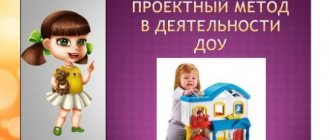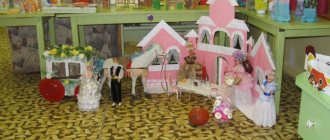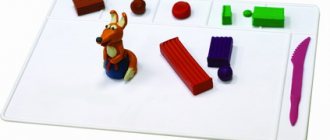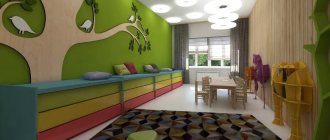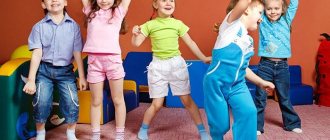Article “Methodological recommendations “TYPES OF THEATER IN KINDERGARTEN”
3 Horse Theater
What is a horse theater? This term was introduced by Russian puppeteers back in the 16th century. Its peculiarity is that the dolls are taller than the person who controls them. There are the following types:
Reed theater uses puppets, which are mounted on a high cane, and the person who controls the characters is hidden behind a screen.
The Bi-ba-bo theater is becoming increasingly popular. In principle, this is the same “glove”, since the dolls are put on the hand. The only difference is that a high screen is used and, thus, the characters are shown to the audience at a level higher than the puppeteer’s height.
No less interesting is the theater of spoons in kindergarten. It is very easy to make attributes for such gaming activities yourself. For this you will need a wooden spoon. The character’s face is drawn on its convex part, and the clothes of a fairy-tale hero are put on the handle. During a children's play, little puppeteers hold spoon characters by the handle.
Stock doll
.(cockerel, ducklings, dog, bear, etc.). These dolls are driven with the help of one or two rods (sticks). They are very useful for the development of fine motor skills, which contributes to the development of speech in children. These dolls also develop flexibility in the fingers, hand and wrist. When working with young children, dolls on one rod are used. The teacher teaches how to hold the doll with all fingers (in a fist). The doll moves due to the movements of the hand. Older children control the dolls on two rods. To manipulate such dolls, you need to teach children to hold the sticks only with their fingertips.
Mastering stock dolls.
At stage 1, the teacher shows a performance in which he introduces children to new dolls.
At stage 2, the exercise “Download, sticks!”
Exercise “Stoolka”. A stoolka is a stick with a flat circle at the end, to which threads with balls are attached on both sides. You need to hold the stick with three fingers (thumb, index and middle), and if you twist the stick with your fingertips, the balls will hit a flat circle. Children enjoy playing with the doll and at the same time they develop the skills necessary for puppeteering.
At stage 3, a theatrical game is held, during which children learn to move a doll along the edge of the screen. The teacher gives everyone a stock doll and improvises a fairy tale in which all children must participate.
Bi-ba-bo puppet theater (or "Petrushki" theater)
The Petrushki Theater is a theater whose puppets are worn on three full fingers of the hand - like a glove. In Italy, these dolls used to be called burattini, now they are called pupattzi. In Russia, this puppet character was named Petrushka. Petrushka traveled from fair to fair for a long time, until in 1924 he finally found his home in St. Petersburg. And it was then that a permanent puppet theater for children was organized. These dolls can be purchased at children's stores or made by yourself. The simplest doll consists of a shirt body, a head and arms. The body-shirt is cut from fabric according to the puppeteer's hand. The head can be made of different materials: wood, bread, plasticine, a plastic ball, but usually papier-mâché. Or you can use old dolls or rubber toys that you may be planning to throw away. If you take the head of a rubber doll and sew a new costume onto it (so that a child’s hand fits through it), then the doll will come to life, and it can be used in theatrical performances. The doll is put on like this: on the index finger - the head, and on the thumb and middle finger - the arms or paws. If the doll is too heavy for a small child, then a gapit (a wooden rod with a comfortable rounded handle) comes to the rescue. The stage of the parsley theater is a screen. The scenery is placed on it, and the action takes place. Behind the screen there are puppeteers who control the puppets and speak for them. Puppet theater brings children a lot of joy and pleasure, creates a good mood in them and is vividly reflected in their creative games.
Puppet show
Puppet theater helps develop a child's speech, imagination, and fine motor skills. Every parent can make a home puppet theater with their own hands, especially if the kids take part in the exciting process.
A puppet theater is made from various available materials, such as:
- paper;
- disposable plastic tableware;
- felt;
- toilet paper rolls;
- socks;
- round cheese boxes.
Do-it-yourself dolls in a home theater can:
- put on a finger;
- put on the hand;
- be stationary.
Plasticine figures
Children love plasticine very much. Now plasticine is produced with a very good composition and bright, saturated colors. If desired, it will not be difficult to mold the necessary character figures and act out scenes from familiar fairy tales on the table.
It is difficult to overestimate the benefits that such activities bring to children:
Note!
Do-it-yourself bead brooch: photos of the best options, step-by-step master class on how to create it yourself, weaving patterns
Do-it-yourself felt toys - TOP-120 photos of toy ideas, do-it-yourself instructions for making them for beginners
How to make a lapbook with your own hands: a detailed master class on how to make it yourself, reviews of lapbook elements
- develop fine motor skills, memory, imagination;
- forms coherent speech, teaches retelling;
- introduces children to literary works, broadens their horizons, instills love in artistic creativity...
Is all this comparable to spending time in front of a tablet or phone? This is a rhetorical question - the answer is obvious!
It’s strange, but in the modern world, when we have so many helpers around the house and many processes are mechanized and automated, we often don’t have time to play with our own children. Creating a small theater with your own hands will appeal to both children and adults, and who knows, maybe these few hours of time spent with your child will remain in his memory as the best childhood memories.
How to make your own screen for a theater in a preschool educational institution
In order to organize theatrical activities with preschoolers, you will need various attributes, including masks, dolls, and decorations. Of course, the necessary equipment can be purchased in specialized stores. But by inviting children to make the necessary equipment for the theatricalization of a fairy tale, it is possible not only to diversify the educational process of preschoolers, increase motivation for work, but also to realize the main educational and educational goals.
What can you use to make a theater for preschoolers? For most types of such creative activities, a theater screen is required. In kindergarten, there is usually the specified equipment either in the playroom or in the music room. But if you don’t have a screen of the required size, you can make it yourself.
The easiest way to make such an attribute for a theatrical game is to stretch thick fabric over the doorway. Depending on what type of activity is supposed to be carried out, a “window” is either cut out in the material or an indentation is made at the top to accommodate the characters.
Living Puppet Theater
But more often than others, a “live” puppet theater is organized in kindergarten. Such activities can be carried out as a lesson on the development of speech, the surrounding world, learning a foreign language, as well as during leisure time. In addition, a live theater production can be dedicated to a holiday, for example, Maslenitsa or New Year.
The following types of described gaming activities are distinguished:
- masque;
- theater of giant puppets.
The latter is most often carried out as a leisure activity in a preschool educational institution. The roles of giant dolls are played either by adults or older preschoolers. Younger children can only act as spectators.
Then the mask theater is suitable for children of any age. Even the youngest pupils have the opportunity to “reincarnate” into the hero of a fairy tale. The teacher can invite the children to retell a story the kids love in such an unusual way or prepare a full-fledged performance for their parents.
Preschoolers can make masks for the upcoming performance on their own under the guidance of a teacher, for example, during classes on artistic and aesthetic development or during leisure activities.
Floor theater
Floor theater uses puppets. Making them yourself is quite difficult, so most often they are purchased in specialized stores. Due to this feature, this type of theatrical activity is rarely carried out in kindergartens. But it is the puppet theater that evokes a storm of emotions and delight in preschoolers. Since children do not yet understand the mechanism of action of such dolls, children imagine that the toys themselves have “come to life”. It is this element of “miracle”, “fairy tale” that contributes to the emergence of positive emotions in preschoolers.
Sock theater
Sock characters are funny, because on a long neck they only have a head with an opening mouth. Geese, snakes and fantasy characters are made from socks.
Interesting theater-themed crafts can be made from plastic spoons, empty plastic cans and much more. Competition at school
School crafts on a theater theme can be made using different techniques.
Option 1
A three-dimensional applique is suitable for a school competition.
You will need:
- colored paper and cardboard;
- velvet fabric;
- glue, stapler.
Progress:
- Print the facade of the Bolshoi Theater and the ballerina.
- Fold the A4 sheet in half, stick a printout of the facade on the top, decorate with columns made of paper (screw it onto a tube).
- Decorate the inside of the folded sheet with velvet, and stick a ballerina figurine on top.
Option 2
A miniature theater with your own hands will attract the attention of spectators who will examine the crafts.
You will need:
- small rectangular box;
- fabric, twisted cord;
- chenille wire;
- plasticine, threads;
- decor – voluminous stars, sparkles.
Progress:
- Decorate the box as a stage. To do this, cut off one of the wide sides of the box to create a stage. The inside is covered with white paper, the floor is made brown or green.
- A small horizontal curtain is placed above the fabric stage; the side parts of the curtains are decorated with fabric. The folds are draped and secured with a twisted cord. They also cover the top of the box to disguise the connection between the fabric and the cardboard.
- The body of the characters is made of plastic, plasticine, self-hardening mass; arms and legs are made separately from the same materials. They are attached to the figurine with chenille wire. Threads are attached to all parts of the figurine, which are led up into the wings, where they are secured. The result is a puppet figurine.
Option 3
Many schoolchildren are interested in origami. This is an excellent material for creating crafts for a competition.
You will need light green, blue and purple stripes, a ready-made mask, glitter glue, and acrylic paints.
Progress:
- Design a mask. Draw the eye in black and the mouth in blue. Around one eye, make fancy patterns of blue and purple colors. Add glitter.
- Roll paper into rolls and make petals.
- Place a mask on the base—a sheet of cardboard—and place rolls and petals around it. Decorate with sparkles.
Option 4
Almost every home has a lot of scraps; they will be useful to make a bright panel on a theatrical theme.
Having determined the plot, they make a full-size diagram of the future panel and select scraps of different colors and textures. Elements are cut out from them and sewn on by hand or by machine.
The combination of flat and three-dimensional elements on a panel looks interesting; knitted or sewn parts are suitable for this.
Option 5
High school students will love the collage idea. The frame is used as a basis, the backdrop is covered with canvas.
The frame can be:
- made of wood, narrow or wide;
- antique tinted;
- baguette with patterns, painted gold.
The frame is decorated with old theater posters, programs, printed faces of actors, masks, and dried flowers. The edges can be decorated with fabric curtains.
Materials for making characters
What else can you make puppet theater characters from:
- cardboard, making two holes for fingers in the lower part;
- matchboxes;
- tennis balls;
- inflatable balloons;
- disposable tableware: plates, cups, spoons;
- socks, mittens, gloves;
- plastic bottles;
- natural material, etc.
Thus, you can organize different types of theaters in kindergarten. When planning such activities, it is important for the teacher to take into account the age and individual characteristics of the students and their interests. In addition, it is necessary not only to correctly conduct a theatrical game, but also to methodically correctly think through the preparatory and final stages of working with children. The effectiveness of pedagogical work with preschoolers in general depends on these factors.
Plot-script
For the plot, it is very convenient to choose the famous Russian fairy tales “Teremok”, “Kolobok”, “Masha and the Bear”. The main characters are animals. animal puppets for a puppet theater with your own hands : on the Internet you can easily find a large number of patterns, both simple and complex. Or you can use soft toys such as a fox, a hare, a bear as animal dolls.
Russian fairy tales are very fertile material for production. The characters are simple and understandable, and the repetitions in the plot that fill fairy tales contribute to the development of memory in children and promote the development of speech. In addition, these fairy tales are well known to parents, so creating a performance based on them will not be difficult.

